Sous Vide Salmon – PolyScience Sous Vide Professional

Happy weekend to you! If you are a frequent reader of Bunkycooks, you know that we spend a lot of time meeting with and interviewing some of the best chefs in the Southeast. We have learned so much while talking with them and getting to spend a little time in their kitchens. We have also dined at some pretty incredible restaurants along the way. I am always interested in two things while we are On the Road visiting these chefs. One is the source and quality of ingredients used and the second is the cooking technique.
There are several themes that are recurring. Obviously, the freshest local, highest quality ingredients are needed to make extraordinary recipes. In addition to the ingredients they use, many chefs have adopted a cooking technique called sous vide. Since we already spend lots of time and countless dollars working with the best ingredients in our own kitchen, we decided to learn more about sous vide.
Sous vide is the French term for “under vacuum” and is a technique that cooks food in a vacuum sealed (cryovaced) bag submerged in water. The water is circulated in the pot/tank and the temperature is perfectly and accurately controlled. The objective is to cook the food to a very precise temperature. No overcooking. No undercooking. Foods that are cooked using the sous vide method are prepared just right and perfectly cooked throughout. The food is removed from the bag just prior to serving and seared in a very hot skillet. Searing provides the wonderful caramelization and appealing color, adding to an already perfectly cooked and seasoned food.
Chef Kevin Rathbun, of Rathbuns’s and Rathbun’s Steak in Atlanta, mentioned two reasons why he has adopted sous vide in his kitchen. Firstly, it creates a perfect dish that is ready when you are since it can be made ahead. Secondly, it creates a cleaner kitchen. There are fewer pots and pans and much of the mess is thrown away in those sealed bags when the food is removed.
Ready when you are and less mess in the kitchen got our attention. 😉 We looked into the various sous vide alternatives and decided to work with PolyScience Corporation to give sous vide a workout in our own home kitchen. PolyScience is the choice of most chefs that we have worked with. We received our PolyScience Sous Vide Professional Model about two months ago and have been cooking everything from fish, steaks, roasts and scallops to eggs and vegetables.
Now, before we go any further, let me just say that there is one negative report about sous vide. There is the potential for bacteria to grow in the cryovaced bags which can be very harmful to humans. However, this only occurs if you keep the food cryovaced for extended periods of time or store it at the wrong temperature. For everything that we did, we sealed and used the food within a 2-day window and stored it in the refrigerator. Most people will seal the food in the vacuum bag, cook it and eat it the same day. There is never a problem when used properly or when the food is consumed soon after sealing and cooking. So, if you are considering sous vide to prepare food 3-5 days or a week ahead of time, you need to read and follow the directions for storage carefully.
So, what have we found?
We bought a center cut tenderloin (Chateaubriand cut) of locally raised beef and prepared it . Wow! We were very impressed. The beef was perfectly cooked throughout. The flavors were more intense as the spices infuse deeper into the meat when they are cryovaced.
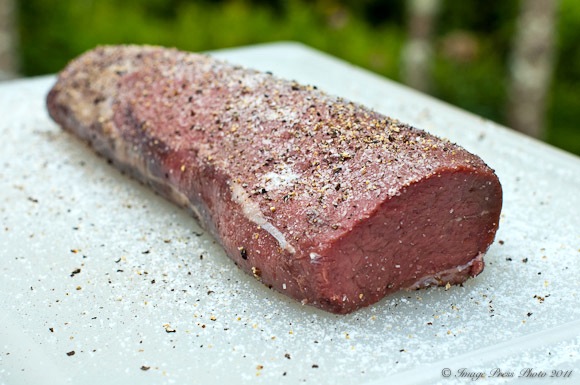
This was a beautiful piece of local grassfed beef
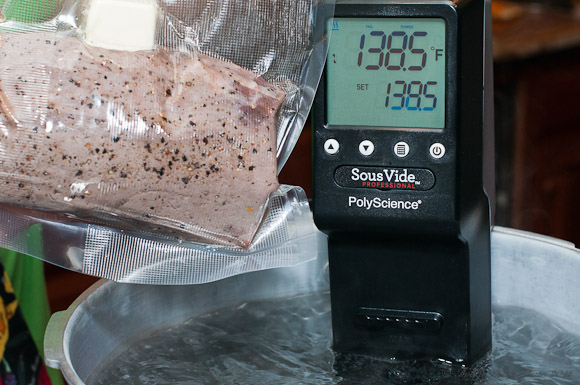
Insert the slightly browned and seasoned beef into the water to cook
We prepared this tenderloin ahead of a dinner party. I knew that I didn’t want to be fussing in the kitchen when my guests were arriving. I wanted to spend time more time chatting and drinking wine (are you really surprised at that?!) and not worrying about the food. Every piece of tenderloin was perfect. Even though the tenderloin has a thick end and a thin end, the meat was evenly cooked throughout. Normally, I end up with a section that is overdone and a section that is too rare. Not this time. It was perfect. Chateaubriand is typically cooked to 132 degrees Fahrenheit, however I like mine a little more done (medium rare), so we cooked it to 138.5 degrees Fahrenheit (140 degrees is medium). Just the way we like it.
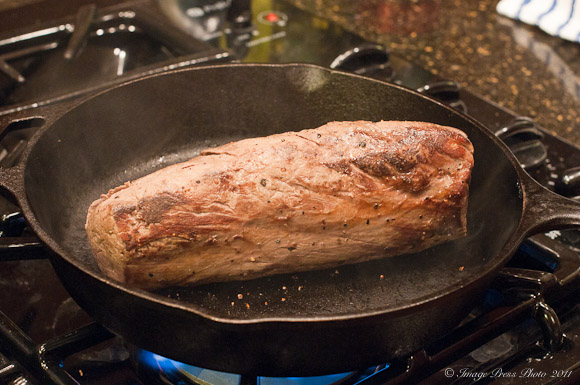
Give the meat a nice sear
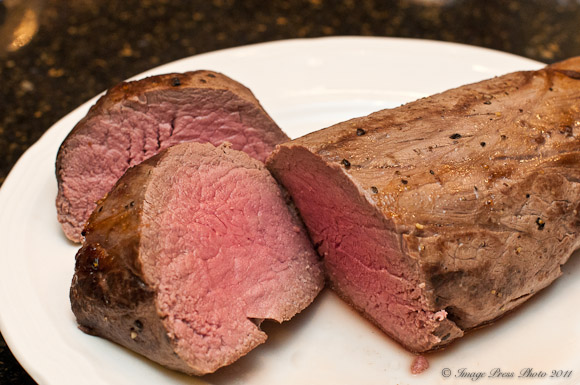
Perfectly cooked beef
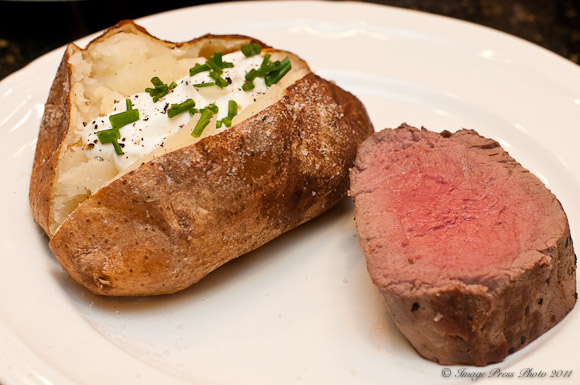
This is my kind of dinner!
Our salmon was excellent! Once again, it was perfectly cooked throughout. We like our salmon slightly undercooked, so we chose a temperature of 138.5 degrees Fahrenheit and added some fresh dill and lemon to the bag that was immersed in the sous vide bath. Add a nice sear when done and you have wonderfully flavored and perfectly cooked salmon.
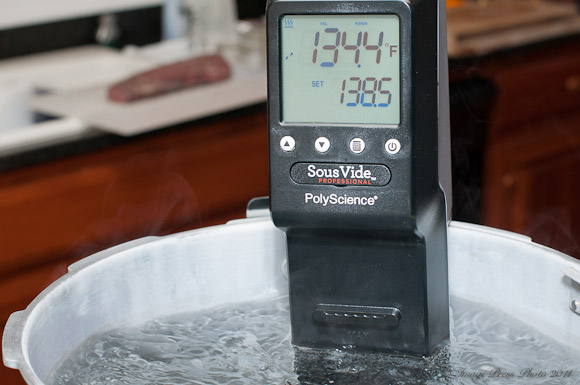
The temperature for the salmon needs to be 138.5 degrees Fahrenheit
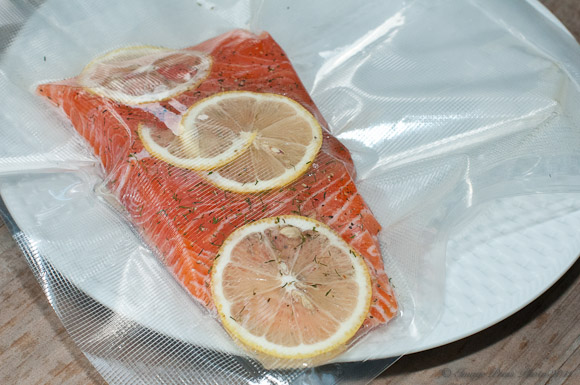
Cryovac the salmon fillets with the dill, butter and lemon
On the other hand, our scallops were not perfect. The flavors with the lemon and thyme were excellent, but we learned a lesson about vacuum sealing. If you apply too much of a vacuum seal, you will crush a soft meat or muscle, like scallops, and they become compressed and too firm. We will know better next time.
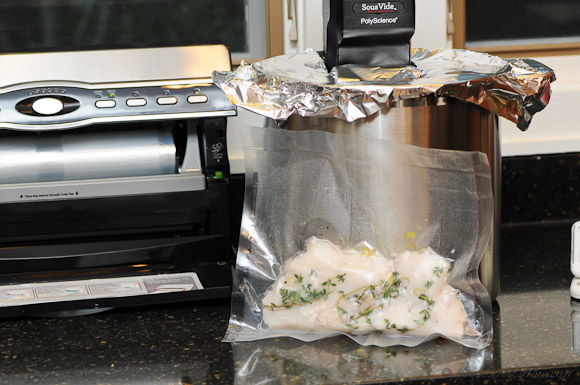
Extra care needs to be taken when cooking scallops
Fish requires 10-15 minutes to cook in the sous vide. Meat is typically done in 30-45 minutes. Vegetables, like carrots, can take 45 minutes to an hour to cook. We chose carrots as our initial vegetable. Once again they were perfectly cooked, however, I can’t say we loved the recipe. We tried cumin with the carrot, as suggested in the cookbook, but I would use some other herbs and season them differently next time.
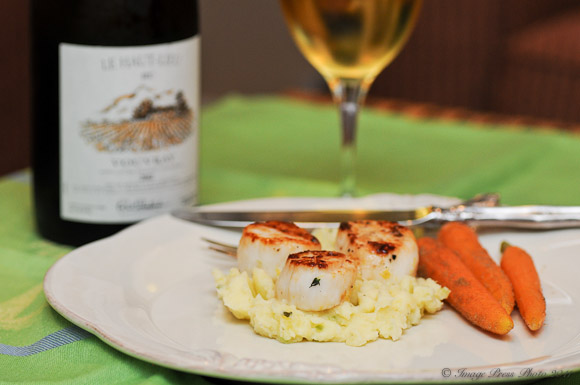
We prepared the scallops and the carrots in the same evening
This brings me to one of our favorite surprises, eggs. You can have the ultimate egg with sous vide! Cooked exactly like you want it. We chose 75 degrees Centigrade. The white almost had a creamy texture and the yolk was done but not overdone. There was no telltale overcooking that shows up as that green/blue ring between the yolk and the white. For recipes that require eggs cooked to a certain doneness (from very soft to firm), sous vide makes it easy and you can do it ahead of time.
The other major benefit of sous vide is that the cooking time is less precise. It reaches a certain temperature as controlled by the sous vide processor and then it stays at that temperature, regardless of how long you cook it. Imagine leaving a Chateaubriand (that you spent major bucks on) in the oven for an extra 20 minutes. Not a good thing. With sous vide, if it is done in one hour, it is essentially the same doneness in 2 hours.
Better yet, allowing the food to cook longer in the water bath makes it more tender. The water bath breaks down collegans and the longer it stays in the bath, the more the collegens are broken down and the more tender the meat. Our tenderloin could be cut with a fork.
I will say that the longer it cooks beyond the recommended time you will lose internal juices. So, while the meat may be tender it is not as juicy if left in the water bath too long. A tenderloin that is cooked 45 minutes to an hour is far juicer than one that is cooked for 4 hours. This is something you need to perfect over time.
To me, the major advantage of sous vide is that I can prepare for parties ahead of time and that I don’t have the same big messy kitchen afterward. For certain dishes, sous vide can’t be beat for perfect preparation. The salmon was just the way we like it. The tenderloin melted in your mouth. When you saute it in a pan and then perhaps, finish it in the oven, it is more difficult to find that perfectly cooked meat.
If you entertain often or are as fussy as we are about the preparation of your food, or you like to prepare dishes ahead of time, you may also be interested in trying the sous vide method. We have a long list of dishes that we plan to try. Next up is lamb chops, so stay tuned!
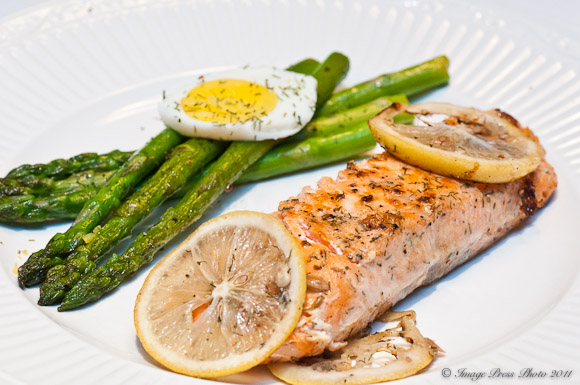
The fish was beautiful and perfectly prepared. Notice the perfect preparation of the egg.
Have a great weekend!
Disclosure – Polyscience has provided the Sous Vide Professional for our review.
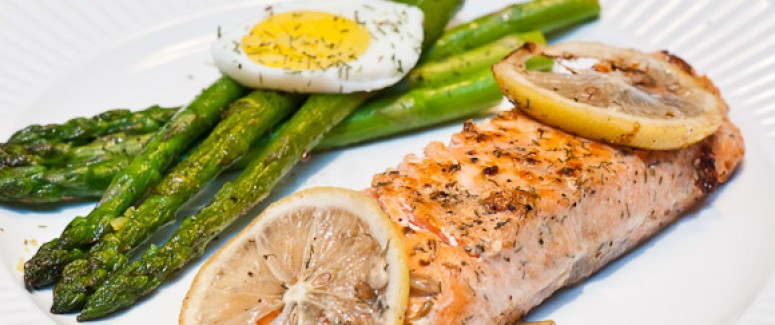
Sous Vide Salmon
Ingredients:
3-6 oz. fresh Wild-Caught Salmon Fillets
Freshly ground Sea Salt
Freshly ground black pepper
3 fresh dill sprigs, snipped
3 Tablespoons unsalted butter (1 Tablespoon per fillet)
1/2 fresh lemon, sliced thinly
1/2 fresh lemon, juiced
Directions:
Season the salmon with olive oil and a sprinkling of salt and pepper. Apply freshly squeezed lemon to each fillet and 1-2 thin slices of lemon to each side of the fillets. Sprinkle snipped, fresh dill over each fillet.
Place each fillet in a separate cryovac bag. Add the butter (While there are special vacuum sealers for Sous Vide, most home cooks can use a traditional vacuum sealer like Foodsaver or Seal-a Meal).
Vacuum seal the bag to 60% vacuum. You will want as much air out of the bag without drawing so much air that it compresses the fish. The key is to eliminate air pockets so the fish is in direct contact with the bag without compressing the fish.
Bring your immersion Sous Vide to 120 (rare) to 125 degrees (medium rate) Fahrenheit. Meanwhile your fish will marinate.
Place the bag in the immersion tank and allow to circulate in the hot water bath for 12-20 minutes depending on the thickness of your fillet. Remember, you won’t overcook the fish with the longer temperature but you will lose moisture.
When the fish is cooked, remove the bag from the pot and take the fillets out of the bag. (You can double-check the temperature by inserting the thermometer directly into the fish.)
Heat olive oil in a saute pan on high heat until almost smoking. Place the fillets in the pan, presentation side up, for about 1 minute to create a golden crust.
Remove from the pan and serve immediately.
Our experience shows us that you have to experiment with a recipe to get the temperature the way you like it.